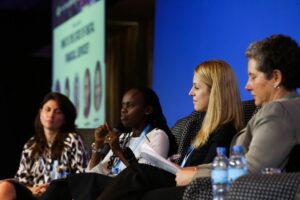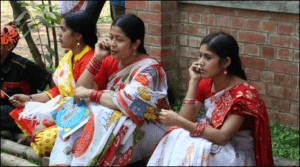The future of women’s financial inclusion is inextricably linked to the potential of digital technology to break down barriers to women’s access to and usage of financial products.
When it comes to financial inclusion for women, “digital financial services” (DFS) means different things in different markets. In some, DFS means the booming mobile money sector that is opening up unprecedented access to formal banking. In others, DFS is still just another unreachable tool for those without access to mobile phones where cash is still king.

Moderator Diana Gooley, Women’s World Banking’s Digital Financial Services Manager, opened the session with the question: “What do you think have been the biggest accomplishments in the past 10 years?”
It’s a big question. Ten years in the digital technology sector is a lifetime. However, we need to look back before we can chart a path forward. The responses from our panelists were revealing as they focused not just on DFS itself but on the holistic benefits to women clients.
Digital enables more than financial access

Marie Kyle, representing mobile insurance provider BIMA, also pointed to the doors that mobile money are opening for women. By providing women who traditionally had unequal access to bank accounts with access to digital payment channels, they can connect to other new services like health insurance.
Kyle said, “What DFS has done is started to level the playing field a bit. Provided you have access to a mobile phone, you can access the same services as male counterparts who are more likely to be banked.”
What’s slowing digital inclusion for women?
Gooley then turned the conversation to the future asking for the biggest challenges and shortcomings of DFS in serving women. Liz Kellison of the Bill & Melinda Gates Foundation pointed to the growth that’s required to reach full financial inclusion for women, particularly given the persistent gender gap in usage. “We haven’t figured out how to accelerate women to adopt and use at the same pace as men.”
How do we make this acceleration happen?

For Women’s World Banking, research is paramount when designing successful products for women. We must do the work to understand women’s unique needs, preferences and barriers before determining how best onboard them and take them on each step of the customer journey. Muhura emphasized this point on the panel. “Women are not homogeneous; we need to go deeper.”
On the other hand, the public sector also has an enormous role to play when it comes to ensuring that that DFS products are accessible to women. Kellison pointed to the example of Tanzania, where the government works to open access through interoperability and less onerous KYC requirements.
Kyle then added “You see a lot of regulators in markets where DFS hasn’t taken off who are willing but, the regulatory landscape is fragmented…DFS means a new ecosystem; regulators who worked in silos in the past now need to work together.”
As Gooley later remarked, we could have kept this panel going for hours as we were just scratching the surface of the DFS environment and its impact on women’s financial inclusion. Check back here on the Women’s World Banking blog for more insights from the Summit on innovative approaches to serving women.



